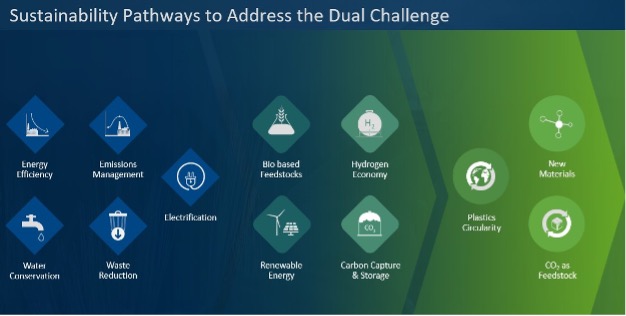As we enter 2023, asset intensive industries are increasingly focused on accelerating progress toward achieving sustainability goals. At the same time, these essential resource providers are faced with a growing population in need of more resources and a desire for improved standards of living. This is what AspenTech refers to as the Dual Challenge, and we are working with companies across industries to develop approaches to successfully tackle this challenge.
There is no “one-size-fits-all” approach to meeting the Dual Challenge. Companies have hundreds of avenues they can pursue, and it is difficult to determine which options are most relevant, which ones work best together and which ones might cancel each other out.
An example scenario might involve a company aiming for a 50% reduction in Green House Gas (GHG) emissions by 2030. First, this company will look at operational improvements like improving reactor yield or fouling management, which can lead to 5-10% efficiency improvements. Next, they’ll examine their assets to identify sites with the most potential for efficiency improvements including the central utility system, which could bring an additional 5-10%. They’re also considering CapEx improvements to revamp existing assets and drive another 5-15% in energy efficiency. Finally, they are exploring strategic investments like carbon capture, Green Hydrogen and bio-feedstocks to make a 20-25% on energy efficiency.
With this complexity of options and related decision making in mind, AspenTech has created structured solutions packages – known as Sustainability Pathways – designed to help customers strategically meet their sustainability targets across the most impactful areas, including:
- Energy Efficiency
- Water Conservation
- Waste Reduction
- Emissions Management
- Bio based Feedstocks
- Hydrogen Economy
- Renewable Power
- Carbon Capture
- Plastics Circularity
- CO2 as Feedstock
The image below groups the pathways into three categories. The five in blue on the left are considered the most established areas that we see our customers most actively pursuing today. The four in the middle are gaining traction and investment, and those on the right are in the early stages of R&D but are garnering considerable attention.
AspenTech has spent the last 40+ years building a wealth of expertise in support of asset intensive industries and has continuously developed solutions to help customers tackle their toughest challenges. We're excited about supporting our customers and partners along the Sustainability Pathways, and over the coming months, my colleagues and I will be providing a deeper look into each of the Pathways and how they’re helping companies address their sustainability goals.



.png?h=415&w=675&la=ru&hash=9BD7B3818E9F0074FE62595AAC06434F)

Leave A Comment